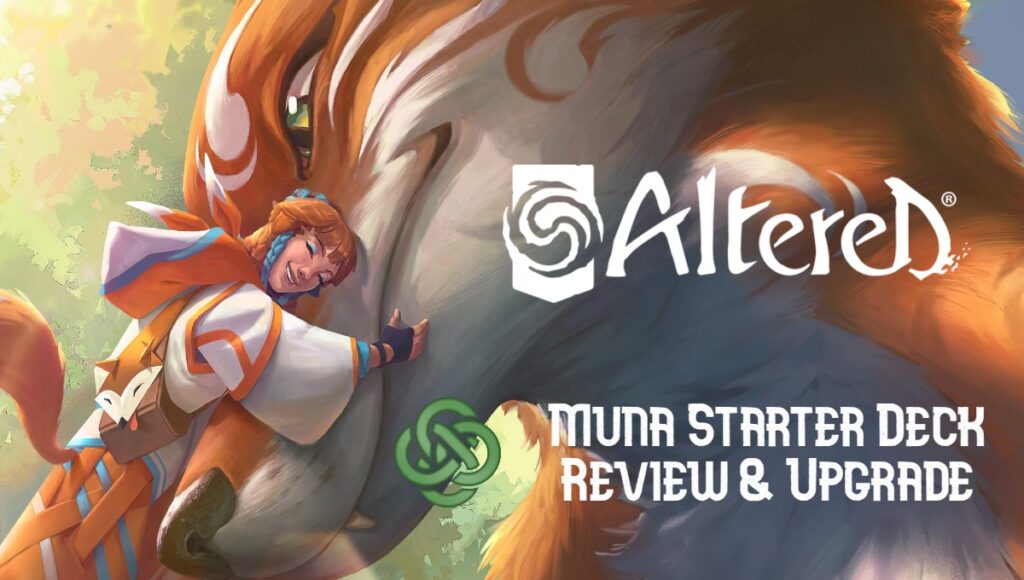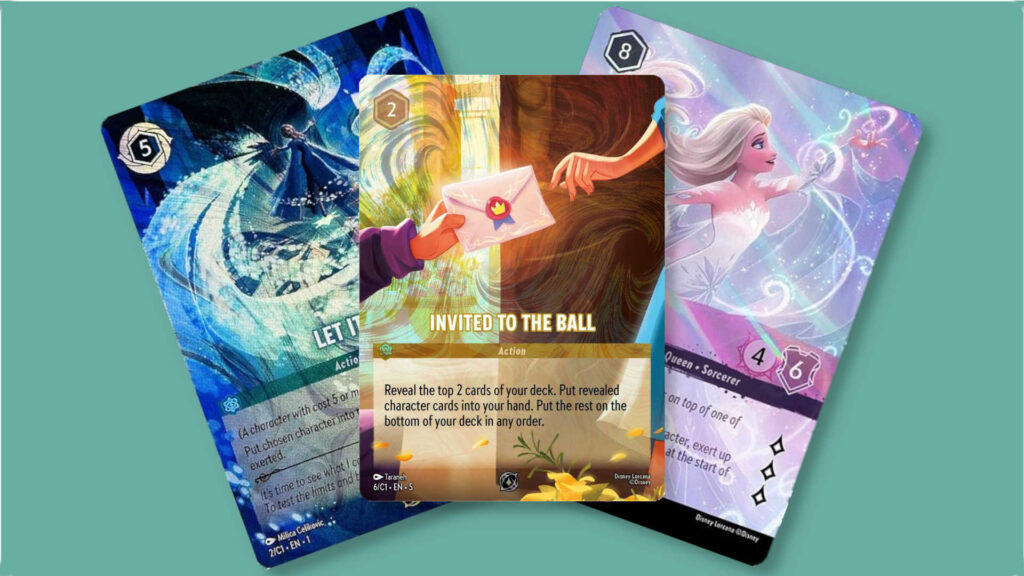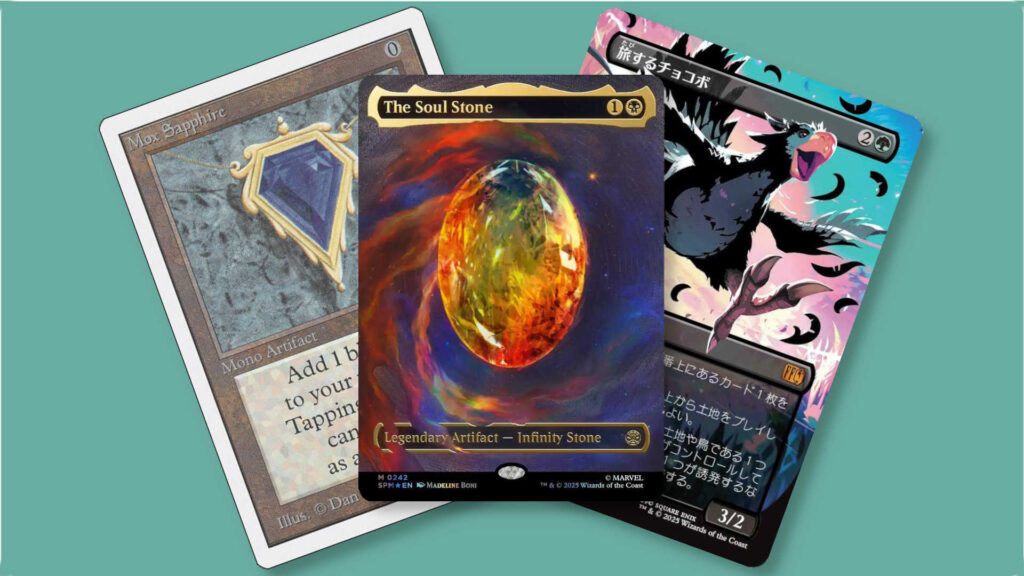Hello everyone and welcome to the first in a hopefully long series of articles here about the Altered TCG! As this is still a new game, the first few articles will be dedicated to reviewing each faction’s Starter Decks and then some suggested upgrade paths. Let’s kick things off by looking at the Muna Starter Deck.
This first article will be slightly longer than the others since I’ll be explaining some of the guidelines and rules I’ll be following for myself when I suggest upgrades. It’s also important to note that the Starter Decks, at least price wise in Australia, are more expensive than other TCGs, and come with no additional packs to help supplement your Altered journey, so picking one that comes with a good selection of commons that are actually appealing and see play in constructed decks is key to success.
Table of Contents
ToggleStrengths and Weaknesses of the Muna Starter Deck
The Muna Starter already has a lot of strengths; Teija is by far the strongest hero currently available for the faction, and a lot of the commons provided are all very synergistic with her ability, either benefiting from the boost over multiple afternoons with Anchored or being above rate on stats to contest easily.
The biggest draw of the Starter in terms of a beginner product is that the cards just work. Starting with the hero herself, Teija doesn’t specify what cards to play with her as long as you’re developing characters, which every deck wants to do anyway. Her ability turns anything that is on-rate decent into above-rate very easily, and has some synergies with cards that care about having boosts.
The Muna faction’s main weakness, as you can tell in the cards provided as well as the wider card list, is its inability to Sabotage, having to dip into the faction-shifted Axiom Scrambler. The starter deck doesn’t include those cards to shore up this obvious weakness, but rather leans harder into its playstyle of sticky threats backed up by a few removal and protection pieces.
Muna Starter Decklist
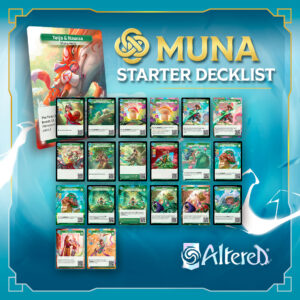
Here’s the complete decklist for the Muna Starter Deck:
Hero
Teija & Nauraa
Characters
1x Yong-Su, Verdant Weaver (r)
1x Coniferal Coneman (r)
3x Spindle Harvesters (c)
3x Kitsune (c)
2x Sneezer Shroom (c)
1x Sneezer Shroom (r)
1x Lyra Cloth Dancer (r)
2x Yong-Su, Verdant Weaver (c)
3x Inari (c)
3x Daughter of Yggdrasil (c)
3x Muna Druid (c)
3x Cernunnos (c)
1x Parvati (r)
2x Coniferal Coneman (c)
Spells
1x Nurture (r)
3x Beauty Sleep (c)
1x Physical Training (r)
2x Meditation Training (c)
1x Meditation Training (r)
2x Nurture (c)
Characters
Cards like Spindle Harvesters, Sneezer Shroom, and Coniferal Coneman are all self-anchoring characters that you want to pile boosts and extra anchors onto with the included Harvests, Meditation Trainings, and rare Physical Training. Combine this with Teija’s ability and there’s a strong core already present in the Starter Deck of boosting up an anchored character to contest expeditions over multiple turns. The Starter also does a great job of hinting towards one of the more synergy-driven ways to build Muna, with cards like Yong-Su, Verdant Weaver calling out Plants as a card type to care about.
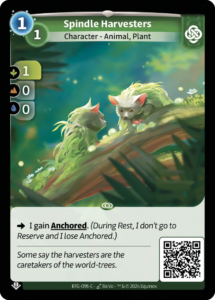
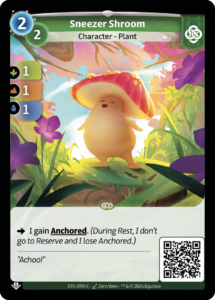
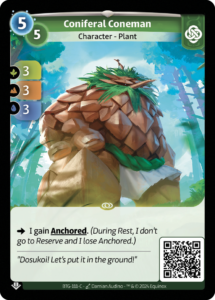
The only real miss in the character lineup is the rare copy of Lyra Cloth Dancer, which honestly feels a bit strange to include since its stats are below rate to compensate for the effect and better removal exists already within the deck.
One of the things I really like about the Muna Starter is how it teaches a new player about where power lies within a character. The self-anchoring characters are all usually below rate for their respective mana costs and really want the innate boost from Teija to be reasonable threats in an expedition. The over-rate characters, on the other hand, all have some minor drawback to offset their stats, with Daughter of Yggdrasil drawing the opponent a card being the primary example.
Pump Spells
The Muna Starter comes with a range of spells to help your existing anchored characters, either by adding on more boosts or re-anchoring them. However, I’d argue that this is the biggest flaw of the deck, and potentially can lead a new player astray. While in a vacuum it’s great to be stacking boosts onto a Sneezer Shroom or Coneman that will stay around for multiple turns, the reality is that there are a lot of removal spells flying around in Altered, many of which “only” send the character back to reserve or into your hand, while also undoing all of the work you dedicated multiple cards into, making it an extremely tempo-negative situation.
The pump spells would be the first area I’d look into upgrading as soon as you have access to the wider card pool, as insulating yourself against getting two-for-one’d is key in such a tempo-focused game.
How Good is the Muna Starter Deck?
Ultimately, this Starter Deck is a great starting point for building Teija in a variety of ways, and provides a good core of commons to choose from whichever direction you may go. It’s also one of the Starters I’d recommend new players pick up, alongside Ordis, as the playstyle is straightforward and introduces you to the concepts of Altered quickly while doing so with some powerful cards.
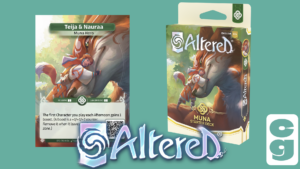
It’s not going to win any tournaments as is, but a lot of the cards present are the types of cards that Muna wants to be playing, even if there are better alternatives in Beyond the Gates. This allows the deck to start on a somewhat solid baseline, and slowly upgrade from there.
Upgrade Paths for the Muna Starter Deck
Before we get into the upgrade paths, I want to set some parameters about how I’m approaching this. I want to keep the upgrades realistic, and don’t expect people to have every single rare at their disposal until the Marketplace or Print on Demand goes live in Q1 of 2025, so I’m limiting rares to just nine, and also won’t include uniques simply due to how deep that hole can go if you’re really looking to optimize a specific strategy.
The Ways to Play Teija
Currently there are two main ways to play Teija: either as a “goodstuff” deck that plays good characters and goes all-in on the synergies with boosting and some plant-matters cards, or a more top-heavy build that has the capabilities to ramp aggressively into a day three Hydracaena.
The ramp style is my preferred way to play Teija currently in Beyond the Gates (though the more low-to-the-ground build has seen great success in online tournaments). It has efficiently statted characters which get pushed over the top with her ability, and a top-end in Hydracaena that provides great inevitability that many factions may find hard to answer, especially in a world where people are playing removal for small-costed cards like Kelon Burst, or scaling removal like Teamwork Training. A good thing about Teija is that a lot of the Muna cards fit in as a small package within the larger deckbuilding framework, and Teija specifically can take advantage of a lot of them.
Package #1 – Ramp
3x Tiny Jinn (r,f)
3x Aja (c)
3x Hydracaena (c)

If there was a definitive “ramp faction” in Altered, it’s hard not to make a case for Muna. This little nine-card package helps to facilitate a clear path to a day three Hydracaena, while also not sacrificing stats on-board to take expeditions. The faction-shifted Tiny Jinn from Bravos is what really sets Muna, and Teija specifically, as being well-equipped to ramp aggressively, with her ability providing the boost innately that the Jinn needs in order to send itself to mana upon leaving the expedition zone, something that Bravos needs to trigger his reserve-play ability for normally. Pair that up with Aja, one of Muna’s over-statted characters that provides a “downside” in both players ramping a mana, and getting to seven mana is simpler than one would think.
Aja in particular is a great card, as her high stats makes contesting her expedition very difficult without committing multiple resources on the opponent’s side, when we’ve already gotten the main benefit from the card on play. Hydracaena is simply a beast of a character, the only card in the game with the Eternal keyword that makes it stay around forever and constantly grows each Noon until its expedition is unable to be contested. I’ve not included the rare copy in this upgraded decklist, but recommend seeking out copies if able due to the built-in Tough X being a great way to protect the giant Dragon you’ve dedicated multiple turns to develop out (it also being a Plant itself is often overlooked).
Package #2 – Plants
3x Daughter of Yggdrasil (r)
3x Kodama (c)
3x Bountiful Meadow (c)
3x Aloe Vera (r)
Additional consideration: 3x Ogun (r)

While I’ve labeled this package as Plants, there are no real synergies present beyond fueling the Tough on the rare Hydracaena, and being cost-reduced off of the Bountiful Meadow if you’re not playing the Oguns. I’ve dedicated most of the intended rares for the upgrades here as I believe that Daughter of Yggdrasil and Aloe Vera make the most notable improvements to the deck’s performance and consistency. Muna as a faction typically lacks card advantage, usually card draw and resupply for anchoring down characters with abilities that trigger at Noon. The self-anchoring gained by the rare Aloe Vera is the one that really sets it apart from the typical common copy, and allows you to still do the same setup plays of playing out a character with a reserve action to anchor but without immediately losing to a single sabotage in between actions.
Bountiful Meadow is a card I’m surprised wasn’t included in the Starter Deck alongside Kodama, since they seem like absolute slam dunks for showing off what Teija wants to do. Yong-Su’s already in the deck, so why not lean into the Plant theme even more? I will say that while the rare copy of Meadow being able to potentially resupply may be appealing, it’s a total trap as it eats a rare slot that could be better served used on characters, and it turns you off of developing a character on turn one if you spend all your mana to resupply (Spindle Harvesters being the one exception).
Package #3 – Anchor
3x Muna Druid (c)
3x Muna Caregiver (c)
Additional considerations: 3x Kodama (r), 3x Meditation Training (c)
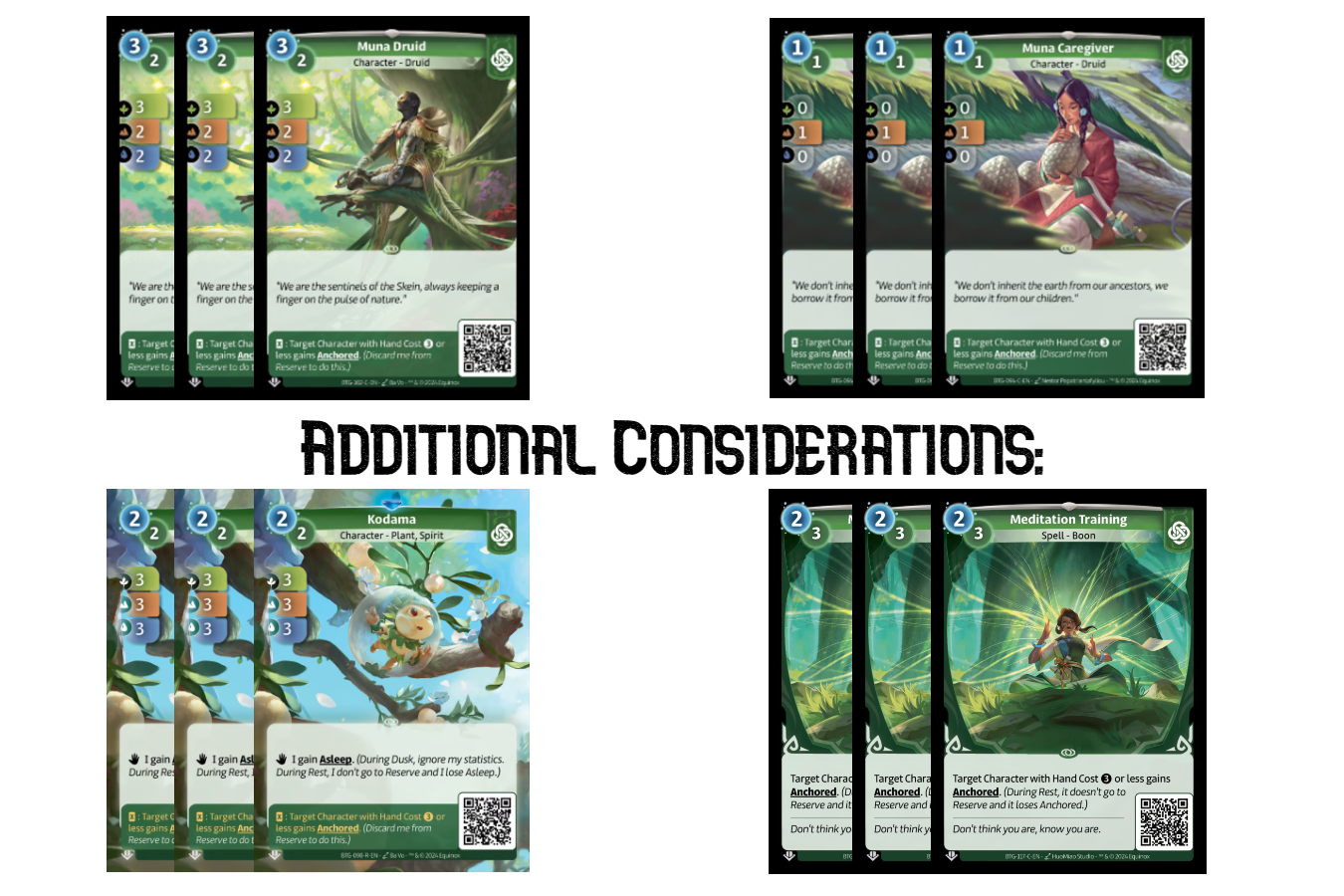
All of these cards functionally do the same thing, in that they have the same reserve action of giving something with Hand Cost 3 or less Anchored. Now in terms of which of the three characters are the best, Muna Druid is by far the worst of the bunch, as Caregiver being a one-drop has inherent value and strength in Altered to pass priority, especially in a curve-out style deck as Teija, and Kodama is still a strong under-statted body on the front side. I only have Kodama in the Considerations area due to the fact that it’s a rare, and eating up those precious 15 slots comes at a steep cost. I’ve come to really dislike Meditation Training, as giving the character Anchored is all it does, and is doubly weak to removal when you’re inviting the self two-for-one. At least the three characters can contest expeditions and play on the front side before expending them to anchor a high-value target like the aforementioned Daughter of Yggdrasil and Aloe Vera, or even something like the Dracaena from the Starter Deck as one of those passive Noon triggers that benefits from the multiple turns of anchoring.
The Best of the Rest
3x The Spindle, Muna Bastion (c)
3x Mana Reaping (c)
Additional consideration: 2x Cloth Cocoon (r,f)
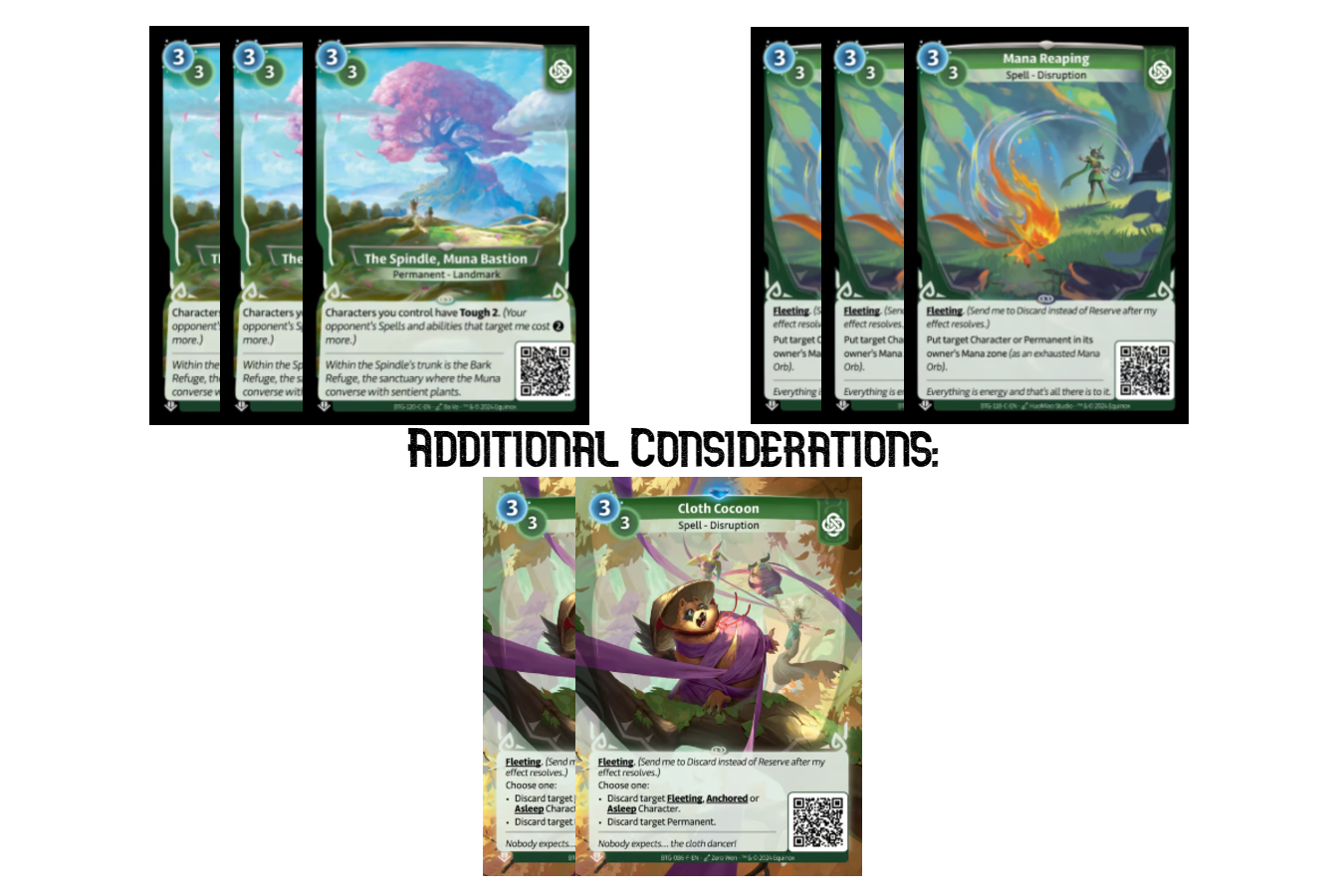
The rest are cards I like to have in my Muna toolbox since they really lean into the strengths of the faction. The Spindle is an insane card, especially against Ordis and Yzmir, who have very limited ways of removing your higher-costing threats. The Tough 2 stacking on top of the rare Hydracaena’s Tough X is particularly nasty against the Banishing Gates, Sticky Note Seals, and Boom! that one would come to expect from the metagame. Mana Reaping and Beauty Sleep are both fantastic removal spells that are in-faction, and both play different roles, with Beauty Sleep really excelling at both putting something like your own Aloe Vera to sleep to extend the resupplying or to strategically put an opposing character to sleep in order to advance.
Cloth Cocoon is faction-shifted over from Lyra and is usually quite versatile, calling out keywords on enemy characters rather than hand costs and being able to take out any permanent, but Mana Reaping’s catch-all ability at common means that you often don’t have to splurge a rare slot on the Cocoons – though they’re really nice to have access to. I also wouldn’t play three Cocoons as it’s pretty bad against an opponent who’s just playing from hand and only really shines against certain matchups where those keywords are in abundance (Waru Bureaucrats, Teija, Fen & Crowbar, Axiom decks in general).
Upgraded Lists for Teija & Nauraa
So here are the two lists I’d recommend upgrading your Muna Starter Deck to. Note that some of the rares used are shared across both builds, so I highly recommend trying to prioritize those, and a card like the faction-shifted Tiny Jinn is such a powerful include in Teija that I’d be surprised if it weren’t a viable option for the hero for the foreseeable future. I think the main core of the deck plays well to a fundamental game plan of good stats for low mana costs and leveraging Teija’s ability to control the board early on.
I’d look to replace the pump spells where not needed for the Tiny Jinns and Meadows to start increasing your deck’s consistency at being ahead of the opponent’s mana curve, as well as Hydracaenas, even common ones, just as a form of endgame. There are a lot of rares that work well in Teija, especially those that are just generically good bodies with above-rate stats that can be anchored by the reserve actions of Muna Caregiver and Druid. So I’d look towards there in the upgrade path.
While I harped on about how much of an upgrade the rare Daughters and Aloe Veras are, the common Anchored package goes a long way to facilitate the common versions of both those cards too. So I wouldn’t hesitate to play them until you can find rares.
Conclusion
While this was a slightly longer article, Muna is one of those factions where the Starter Deck hero has a range of playstyles that it can adopt, so I thought it best to at least touch on two of them. There are a lot of unique things the faction does, including the instant win-con of Lyra Festival shifted over from Lyra, but a lot of those more unorthodox playstyles suits the other two heroes in the faction more.
I’ll be covering Ordis and Sigismar next, so fans of token-based strategies can look forward to it. I’ll catch you all in the next one.
For more Altered TCG content, check out our review of the game here. And don’t miss our guides for the other starter decks: Ordis, Bravos, Yzmir, Axiom, Lyra.

